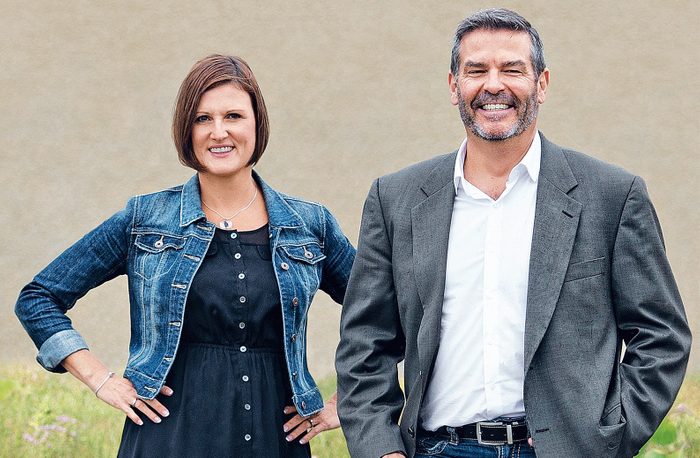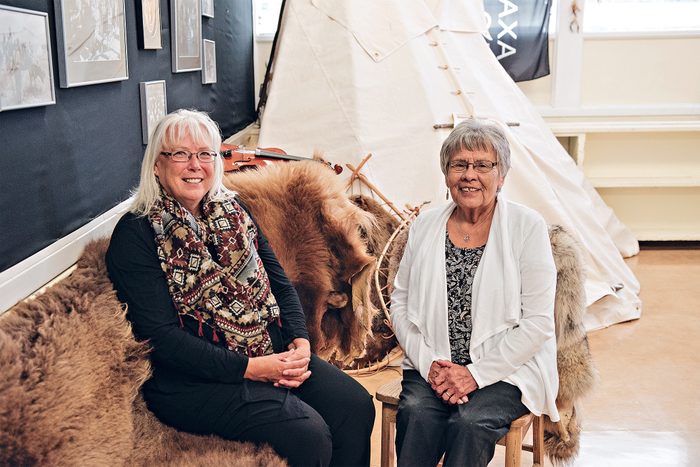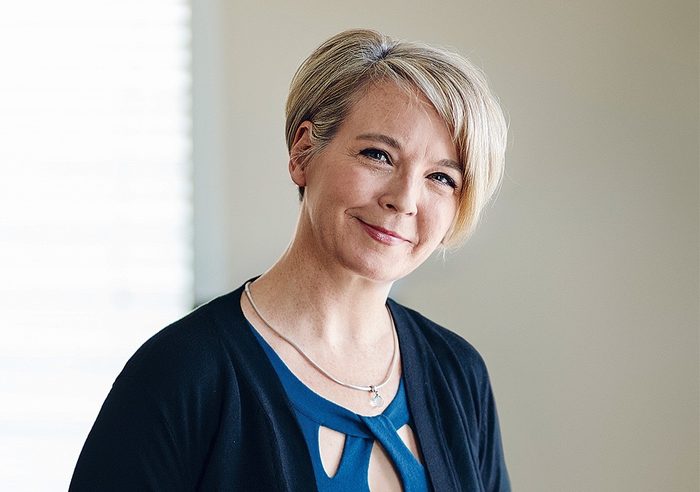
Reader’s Digest Celebrates Innovative Canadian Teachers, Principals and Administrators
We Canadians count on our teachers, principals and administrators. We ask that they watch over our children with compassion. We want them to inspire and encourage, to embrace the future and respect the past, to display mastery and ingenuity. We hope they will be dynamic orators and careful listeners, thoughtful team players and fearless leaders.
At Reader’s Digest, we couldn’t be prouder to celebrate, in partnership with the Canadian Education Association, a handful of educators who exemplify all of the above and even more. Through inventive strategies deployed inside and outside the classroom, they have created programs that promise long-term benefits for students, parents and the school system at large.
We applaud their achievements and look forward to watching these initiatives grow.

First Place, $25,000: Fine Arts eCademy at Navigate, Courtenay, B.C.
At Fine Arts eCademy, it really does take a village. More precisely, to help children thrive, it takes a team made up of fully engaged parents, “community champions” (an aunt or a neighbour, say) and teachers. But the real key to success is the kids themselves. Each fall, the 120 students enrolled in the five-year-old Comox Valley program spend their first week in interviews uncovering a passion-a “spark,” in FAE parlance-with the help of their support system.
“We focus on the children’s gifts from the very outset,” says Jeff Stewart, the principal at Navigate, the public school out of which FAE is based.
The idea that every child is unique and learns in his or her own way isn’t new. The province of British Columbia, for example, launched an education plan in 2010 that homed in on personalized learning. But it’s highly unusual to let students’ decisions dictate the shape of the school year. That crucial difference-developed at Navigate in response to B.C.’s new plan-is one that Stewart, vice-principal Marieke Holtkamp and FAE’s six teachers have embraced with gusto.
Whether they choose to explore topics such as nature, hockey, “building things” or animals, FAE students (ranging from kindergarten to Grade 8 and grouped into five multi-age classes) then connect their passions to the fine arts, which are integrated into projects. And each school year has an overarching theme: in 2015-2016, it was the four elements. Through singing, drumming, painting, acting, dancing, video and other disciplines, students shared their knowledge of how oxygen sustains life and how to harness wind’s kinetic energy and convert it into electricity.
Adaptability is essential to both the students and the program. The school’s calendar is far from orthodox: each interview week is followed by an eight-to-10-week learning cycle that fosters the students’ sparks. Then comes a showcase, where family and friends gather for displays and performances related to that cycle as well as that year’s theme; and a “compass week,” during which pupils attend workshops and visit local artisans while parents and teachers reassess the personal education plans and discuss progress. The entire process is repeated three more times throughout each year.
FAE is also unorthodox in its approach to location: learning isn’t restricted to within the school’s walls; students receive face-to-face classroom instruction three days a week and work from home the remaining two. This mix of on-site education and distributed (or distance) learning is at the heart of the program’s philosophy: knowledge and experience can accumulate in many different ways and in many different places.
“There are students who thrive in the bricks-and-mortar, five-days-a-week traditional classroom,” says Holtkamp. “But many do not. Having an option for them, somewhere they can be successful and thrive, is important. It’s huge.”
FAE students are developing skill sets that extend beyond drama, choir, rhumba, bhangra, pottery and video arts. By taking ownership of their own learning, they’re figuring out how to create their own solutions.
The same can be said of family members. Parental involvement isn’t just vital to students’ success, it’s part of FAE’s genetic makeup. When Dr. Jonathan Kerr packed in his Belleville, Ont., family practice in 2014, the move was motivated by a desire for balance, not just for him but for his wife, Christy Wagner, and their two children (Gwen, now eight, and Tobin, six). When they then relocated to B.C., FAE was a major factor in their decision.
“We do believe it takes a community to raise a child,” says Kerr, and he treats that commitment seriously. He and Wagner are co-treasurers of the school’s Parent Advisory Council, and they helped fundraise for the community garden. For her part, Wagner volunteers weekly with the FAE sewing club.
Kerr has also reduced his work schedule for the next few years so the family can spend time together the two extra days a week that the children are at home. This allows both Kerr and Wagner to be deeply involved in the learning process (among other things, FAE parents are tasked with assisting their kids with reading and writing on home days) and gives the family time to explore their surroundings through library visits and nature walks.
Most importantly, says Kerr, “this schedule has reduced the stress in our lives. Living and learning at a relaxed pace keeps the kids involved and motivated. Plus it’s been wonderful to watch Gwen and Tobin get excited for upcoming performances as they rehearse their parts in the car, at the dinner table and even on hikes in the forest.”
Moving away from a one-size-fits-all education model requires ingenuity, determination and clear-eyed commitment. But trusting students, engaging parents and revolutionizing the timetable pays dividends now-and into the future.
“Our children are learning how to come up with multiple responses to one challenge,” says Stewart. “They aren’t going to rely on other people to provide them with opportunities-they’re going to make their own.”

Second Place, $10,000: Continuing the Journey with the Elders, Cranbrook, B.C.
“Culture cannot be programmed; it is lived.” For Aboriginal-education support worker Debbie McPhee, this statement-the philosophy behind Continuing the Journey With the Elders-is a beacon. Her seven-year-old project to enhance the education of Aboriginal learners, developed for B.C.’s School District 5 Southeast Kootenay, is based out of Mount Baker Secondary School in Cranbrook. It’s proven invaluable to the 1,000-strong student body, of which 15 per cent identify as First Nations or Métis. Since the initiative’s inception, there has been an increase in district-wide graduation outcomes for that group-at 76 per cent, it is now just two per cent below the non-Aboriginal rate and 10 per cent higher than it was a half-decade ago. What can’t be calculated is the tremendous pride the project has instilled in its participants.
Initially a monthly lunch between youth leaders and community elders designed to build cross-generational bonds, it has grown into a full-blown residence for five elders from the Ktunaxa and Métis nations. They have a Gathering Place and Elders’ Room, attend classes, make presentations, speak at assemblies, help students trace their genealogy, sit on committees and share their knowledge of indigenous languages.
For Ktunaxa elder Joan O’Neil, “culture cannot be programmed; it is lived,” is a hard-earned truth. Every Monday afternoon, O’Neil drives the hour and a half from her home in Windermere-where, at 76, she still works part-time at a gas station-to her daughter’s house in Cranbrook. And every Tuesday she heads to Mount Baker, where she might drop in on a photography or law class. She might speak to students about her experiences as a residential school survivor or about Bill C-31-which, when it was passed in 1985, amended the section of the Indian Act that revoked the status of women, like O’Neil, who married non-Aboriginal men.
“I tell students that for more than 20 years, I was nobody. When you’re disenfranchised, you’re not white. You’re not an Indian. Who are you?” says O’Neil. “When I got my status back, I became a person again. And being asked to be part of Mount Baker made me feel even better. I was coming home.”
O’Neil wants the teens at the school and throughout District 5 to have that same sense of belonging. “A lot of the youth don’t know or have lost their grandparents. Many of them were fostered or adopted out. We try to reconnect them not only with the past but with themselves so they have something to look forward to in the future.”
For Kaitlyn Hoeksema, 20, “culture cannot be programmed; it is lived,” is a game-changer. By Grade 10, she was floundering, spending more time doing drugs and drinking than participating in class. After two years at an alternative school, she returned to Mount Baker and joined the Wild Warriors, a leadership group. Now a student mentor at College of the Rockies (“I fell in love with school and didn’t want to stop”), she credits much of her success to having the opportunity to sit with the older generation-and to learning how to dance, sing and play the drum.
When she was eventually asked to teach younger students in the area, she consulted with the elders (since she’s of Cree, Nez Perce and Peguis descent, southeast B.C. isn’t her territory) and was given the green light. “They have always been very supportive,” says Hoeksema. “They’ve encouraged me to look toward my heritage and history, and advocated for forging my own identity.”
Students aren’t always quite as receptive as Hoeksema, but the calming influence the elders have had on the school cannot be denied. “Every- one is better behaved-from students to parents to superintendents,” says McPhee, laughing. “It’s like having your grandparents watching you.”

Third Place, $5,000: Maker Educators Collaborative: Innovation in the Learning Commons, West Vancouver, B.C.
A toy bear with hand-carved wooden snowshoes and a tiny crocheted hat. If Michelle Davis thinks back, that childhood Christmas gift-a handmade collaboration between her parents and her grandmother-is where everything started. It’s what led her to get a graduate degree in educational technology and design, and what inspired her to transform her place of work.
“Growing up, there was always a sewing room or a workshop at home. I was always encouraged to create,” she says.
When Davis, a teacher-librarian, first arrived at Gleneagles Ch’axay Elementary School in West Vancouver two years ago, she knew she wanted to replicate that experience on a larger scale. The answer: a “makerspace,” a physical area where students from kindergarten to Grade 7 could use equipment, whether a sheet of cardboard or a 3-D printer, to design, explore and, ultimately, learn.
In cooperation with col- leagues from three local grade schools and a high school, Davis set up a space in the Gleneagles “learning commons” (a.k.a. the library) where students could tinker. (All four of the schools currently have makerspaces in varying stages of development; Davis and her collaborators would like to equip other institutions across the city, as well.)
For Kelly Richter’s daughters, eight-year-old Ava and seven-year-old Sabina, the makerspace is part of what makes their school cool. And experimenting, rather than following instructions, lets them risk failure-as important a lesson as any. “I was struck by how Ava and a friend became engrossed with figuring out how electronic building blocks could work together in different ways,” says Richter. “They were fearless about making mistakes.”
Davis sees the learning commons as a “library plus,” a hub where traditional skills like reading are complemented by creative problem solving and critical thinking. Working with the different grade levels, she chose five themes to launch its makerspace: robotics, video creation, fabric shop, engineering and building, and design challenges.
Participants have made murals on a giant Lego wall, built an igloo out of 400 milk jugs, come up with a concept for a GPS-equipped dog collar and programmed robots to navigate a handmade obstacle course. But literacy is the engine driving all this innovation. Reading a book about a robot begat the design of a robot, which begat the composition of a story about a robot. And because the kids were writing about something they constructed, their level of investment grew. “By asking the children what they want to make, we are helping them realize that they aren’t just consumers,” says Davis. “They can create new knowledge and give back.”
The students aren’t the only ones who feel empowered. Maker education is grounded in the spirit of community, and that’s reflected in the West Vancouver collective. “We’re made up of teacher-librarians, a vice-principal and teachers at both the grade-school and high-school levels,” says Davis. “You don’t often see this kind of cross-pollination. Pooling our resources has made this experience richer.”